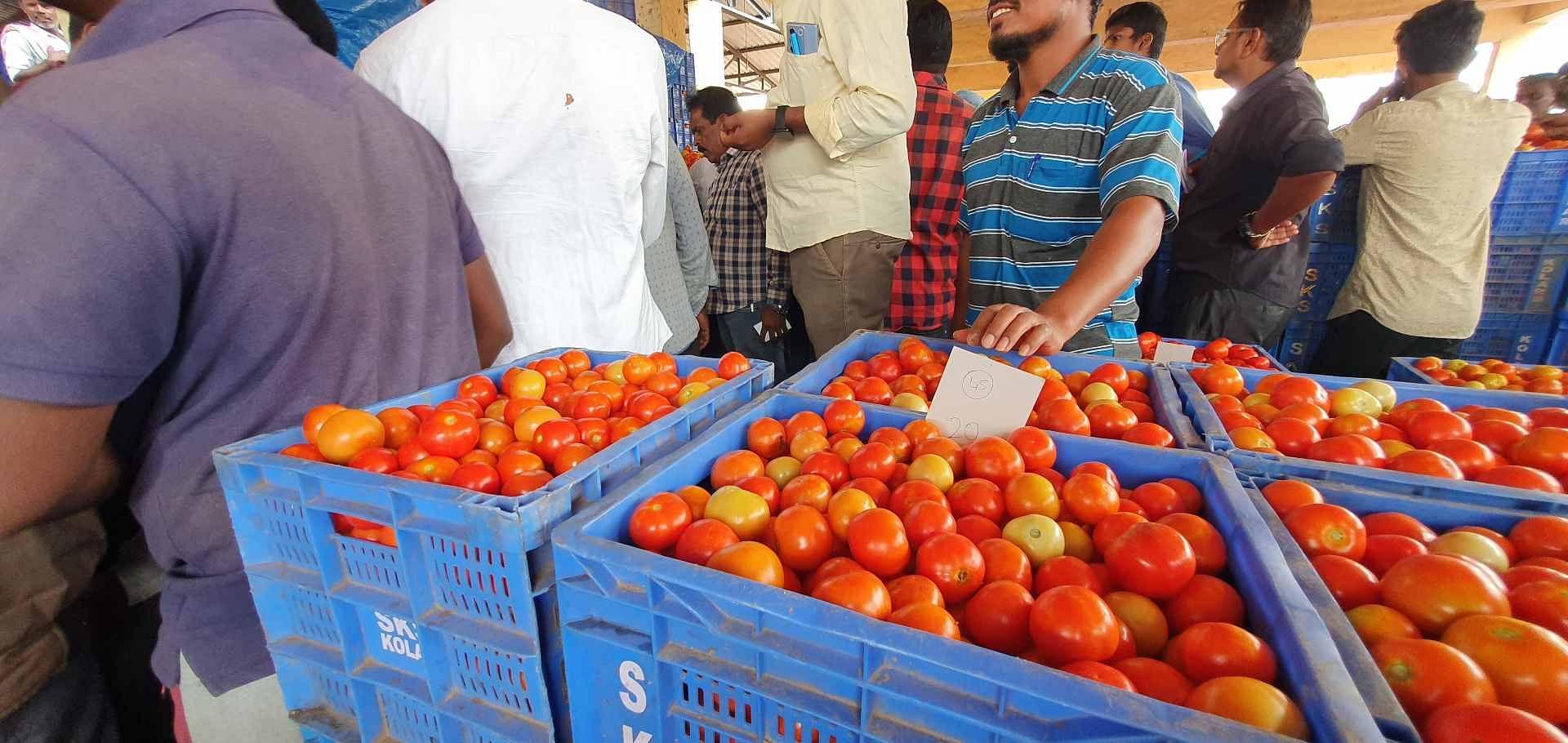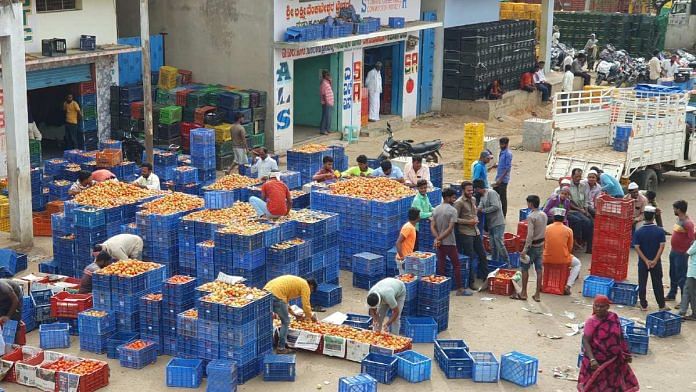Kolar: Tomatoes of all sizes, shapes and colours as far as the eye can see — tucked beside a section of the busy Bengaluru-Chennai highway, the Kolar Agricultural Produce Market Committee (APMC) is the second largest market for tomatoes in Asia after Pimpalgaon in Maharashtra’s Nashik.
For three months every year, Kolar turns into the biggest market for tomatoes in the continent owing to the early end of the harvesting season in Nashik. “From June-August, only Kolar has tomatoes that are sent to all states in the country and even exported to countries like Bangladesh,” said N. Vijayalakshmi, secretary of the Kolar APMC.
But with tomato prices going through the roof in parts of the country, wholesale prices for high-end produce in Kolar, too, are nearing Rs 3,000 for a 15-kg crate of tomatoes.
According to farmers and wholesalers, the high prices can be attributed to surge in demand for the produce, which became scarce this year on account of a poor spell of rainfall, and the compounded effect of change in climatic conditions and prevalence of leaf curl disease for the third year in a row.
Data from the Kolar APMC shows that, in June, at least 3,30,928 quinitals of tomatoes were traded through here, as against 5,45,981 quintals in the same month last year. Between 1 and 11 July, the average quantity of tomatoes traded here (1,31,570 quintals) marked a decline of one-third compared to the same period last year.
Srinivas, a farmer from Srinivaspur, said, “Selling a thousand crates for Rs 200 (each) and 10 boxes for Rs 2,000 (each) makes no difference to us. In fact, the cost of fertilizers, transport and maintenance is so much higher. Since the Covid-19 pandemic, we have not seen any profit. Only losses.”
“We used to get one box worth of tomatoes for every four plants. Now, we need four times as many plants,” he added, using gestures to show how the height of tomato plants has declined from five feet to two-three feet.
The production in June has been the lowest in recent memory, those involved in the APMC say. “We used to get 2,000 to 4,000 crates per day per shed. Now, it is barely 200 to 300,” Saddam Hussain, a commission agent at Kolar’s APMC yard, said.
“Even these goli tomatoes (marble-sized) are going at over Rs 1,000 (per crate) this year,” he added.
Also Read: Heatwave & heavy rainfall or typical annual spike? What’s causing tomato prices to skyrocket
Rise in per-acre cost, price of saplings
Most of the produce traded at the Kolar APMC comes from nearby districts and neighbouring states, arriving round the clock to be auctioned off by noon the next day. One can see hundreds of truck drivers, commissioning agents, retailers, customers and loaders waiting patiently for the auctioneer to arrive at their designated lots to facilitate the trade.
A member of the APMC accompanies each auctioneer to maintain an account of the trade as a small crowd, largely comprising buyers, floats from lot to lot.
Starting from a base price, the auctioneer kick-starts the process, screaming out the prices in three languages and increasing the bids by catching onto the minutest gestures by the purchasers surrounding him.
On Wednesday, Rs 2,050 for a 15-kg crate was the highest bid of the day. That’s roughly Rs 137 per kg at the wholesale level, even before it reaches a vendor or retailer.
However, while the retail price of tomatoes has breached the Rs 150-mark in several markets, this hike in prices has done little for the average tomato farmer or for most of those part of the supply chain.

The per-acre cost of production, farmers at the APMC say, went up significantly this time from roughly Rs 40,000 per acre last year. They add that saplings, too, cost nearly three times as much as they did in 2021.
Tomatoes have a cycle of 90 days.
Having invested around Rs 1.5-2 lakh into his 5-acre tomato farm in Muduvathi village since last year, M.M. Venkateshappa said he was only able to recover a meagre sum of Rs 20,000. “In the last two years, I have accrued debt and commitments of over Rs 18 lakh,” he added.
Even before he completes his sentence, an auctioneer calls out the price for one lot of high-quality tomatoes — Rs 2,000 for 15 kg.
Retail prices in Bengaluru have gone up to Rs 120-130 per kg this week and even higher in some parts of northern India. On Wednesday, the Union government, through the Department of Consumer Affairs, directed the National Agricultural Cooperative Marketing Federation (NAFED) and National Cooperative Consumers Federation (NCCF) to “immediately procure” tomatoes from mandis in Karnataka, Andhra Pradesh and Maharashtra and distribute them in “major consumption centres where retail prices have recorded maximum increase in the last one month”.
In Karnataka alone, two instances of tomato heists have come to light over the last 10 days. This includes a complaint by a woman who alleged that 50-60 bags of tomatoes worth Rs 2.5 lakh were stolen from her farm at Halebeedu in Hassan district. The second case was reported from Chikkajala, where a truck transporting 2,000 kg of tomatoes was allegedly robbed by a gang of three.
Asked how the uptick in tomato prices has affected his business, a hotelier who runs an eatery in Hosakote joked that many are now using “tamarind” as a substitute since it has similar levels of acidity and tanginess. Even the quality of the produce has declined, he added.
(Edited by Amrtansh Arora)
Also Read: ‘Tomato is the new currency?’ & Tagore’s ‘Where The Mind Is Without Fear’



